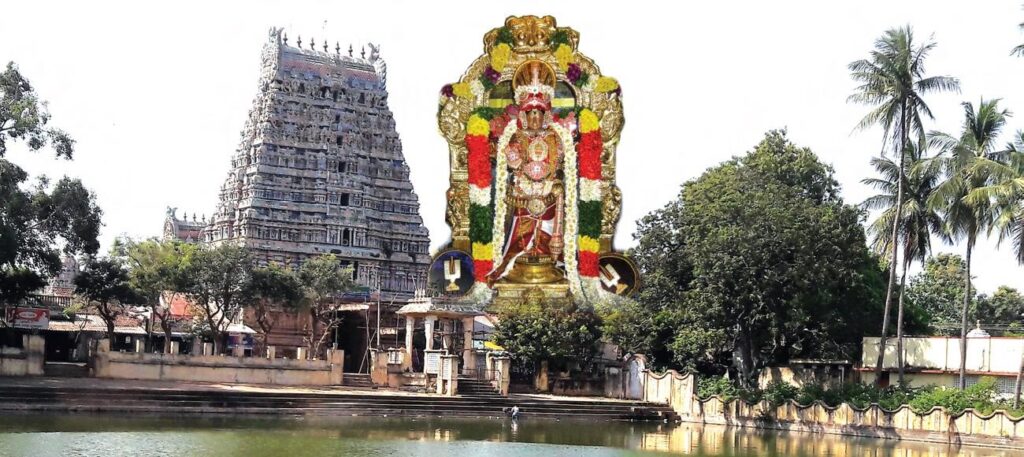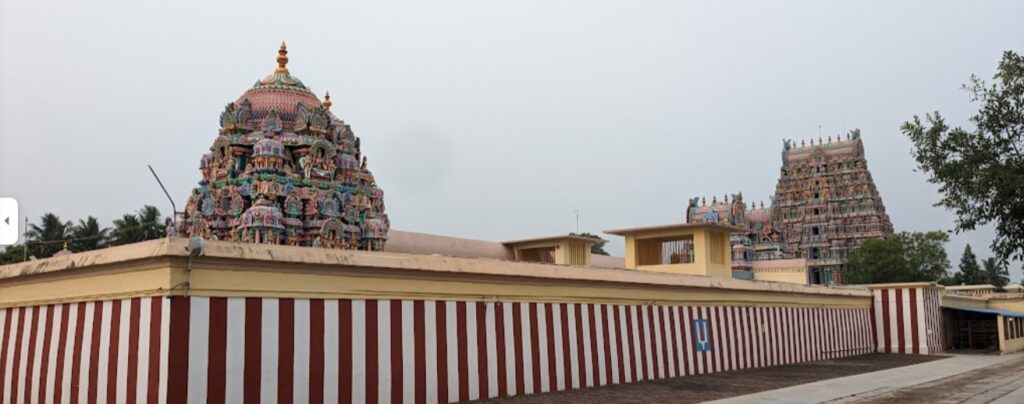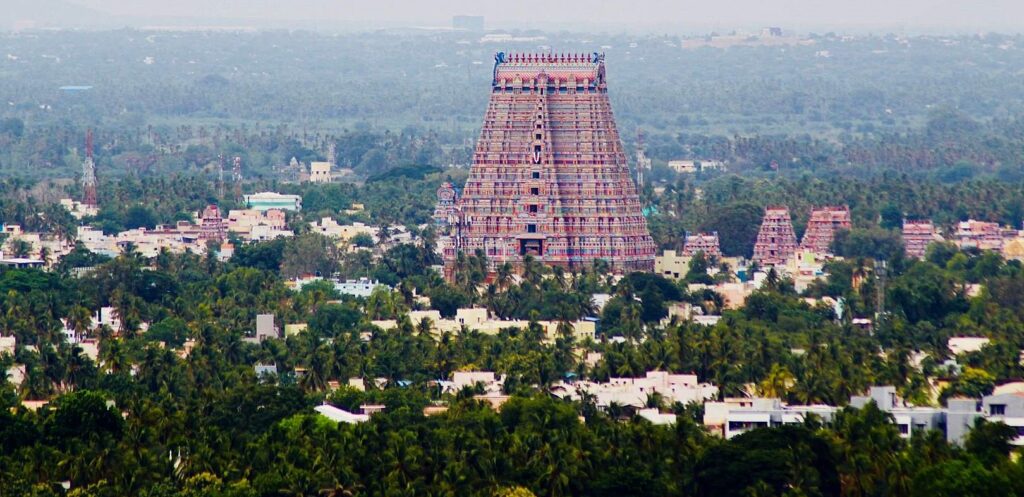Srirangam is an island with the Kaveri River on the south and the Kollidam distributary on the north. The Kaveri River divides into two west of the island and combines east of the island. The temple is in the midst of the island and the newly built Raja Gopuram can be seen from miles away as one approaches.
The Lord is ‘Ranganatha’ resting on Adi Sesha; the Mother Goddess is ‘Ranganayaki Thayar’. The vimana is Pranavakruthi Vimana with ‘Chandra Pushkarani’ as the temple pond.
Sri Ranganatha Swamy Temple
Location
The town of Srirangam is about 10 km due north of Tiruchirappalli railway junction in the South Indian state of Tamil Nadu on the National highway 320 km south of Chennai. It can be reached by air (Trichy airport), by train (Srirangam and Tiruchirappalli junction) and by road using the National Highway (NH).
Click here for Google Maps Location
Sthalapuranam
Maharishi Valmiki in his Adi kavya, Ramayana, clearly states in the 128th sarga in Yudhdha kanda that Lord Rama gifted the titular deity of the Ikshvaku clan (earlier said to be worshipped by Lord Brahma in Satyaloka) to King Vibheeshana. This very same idol was received by King Ikshvaku (ancestor of Rama) from Brahma at his request after severe tapas.
The King of Lanka carried the idol south from Ayodhya and paused to rest on Kaveri River Island and set the idol down. Liking the locale, the Lord decided to stay there and told the Lankan king that he will face south towards Lanka. Thus, came into existence the temple and later the town of Srirangam.
This idol in the temple is associated with Rama Avatara of Vishnu and there are references to this idol in Silapadhikaram which is 2000 or more years old.
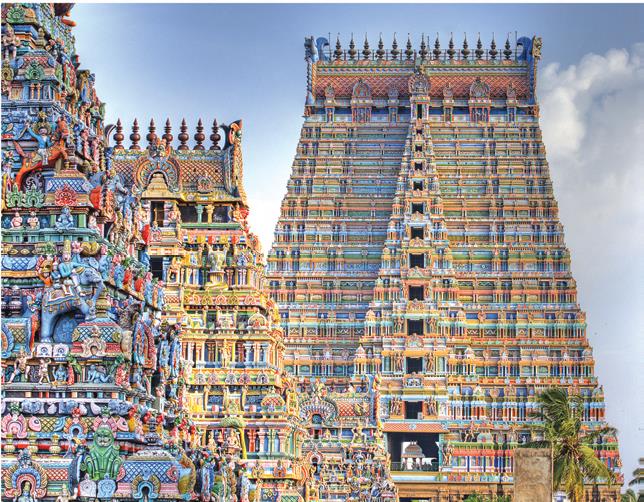
Special features
It is said that Goddess Lakshmi comes to the temple daily to worship. Vibheeshana also visits regularly to worship the Lord. Kamba Ramayana was launched first in the four-pillared mandapam near the Ranganayaki Thayar’s shrine. Alavandar spent many years of his life in Srirangam and was instrumental in bringing Ramanuja to live in Srirangam.
Ramanuja resided in Srirangam for a major part of his life and completely systematized the procedure of temple management and worship here. It still bears his stamp today.
Part of his codification of temple rituals led to the preservation of Divya Prabhandams. He wrote the three Gadyams here in Srirangam and sang them in the presence of the Divine couple. Some say that the Lord and His Consort were in open conversation with Ramanuja during the recital of the Gadya Traya.
There is a legend that his sareera is still preserved in the vasantha mandapam where it was laid to rest after Ramanuja ascended to Srivaikuntam at the end of his mortal existence. The Arayar seva where the hymns (pasurams) are set to music and dance is a very famous feature of this temple and can be witnessed even today.
The Paduka sahasram was compiled by Vedanta Desika in Srirangam in one night. If one goes for a walk around the many concentric streets, it is easy to spot the residences of these Acharyas or preceptors even today. Among the kings and dynasties who supported this temple with gifts of buildings, jewelry, and money were the kings of Chola, Pandya, Vijayanagar, Hoysala, Ganga, and the Nayak dynasties just a few who can be readily named.
The chariot festivals and golden and silver Garuda Vahanam festivals are justly famous in January and April. The horse vahanam and the popular highspeed dash (vayyalli) are eagerly watched by all devotees. The opening of Paramapada Vasal in December- January of every year is very well known.
The grace of Ranganatha and Ranganayaki is so all-encompassing that anything a devotee prays for is granted by them.
Mangalasasanam
All but one of the Alwars have sung in praise of the Lord. All the alwars at one time or the other during their lifetime visited Srirangam and many lived there. Kulasekhara Alwar opens his Perumal Thirumozhi by saying that the gentle waves of river Kaveri caress his divine feet as the gem of a divine form rests on Adisesha.
Andal who started her life in Srivilliputtur finally realized her heart’s desire by merging with Lord Ranganatha making her father Perialwar the Lord’s father-in-law. Perialwar summarises Lord Ranganatha best when he says that the Lord is resting head to the west, feet to the east, back to north and facing South. Seeing Him, Alwar helplessly melts out of love and surrenders.
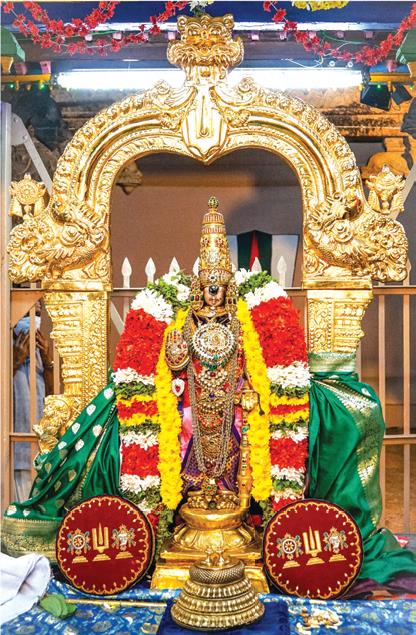
Perialwar was addressed as the father-in-law and was told by the Lord to return to Srivilliputtur after his daughter Andal merged with Ranganatha at the end of her wedding. Thondaradipodi Alwar maintained a garden to supply flowers to the temple.
This Alwar sang the pasuram (called Thirupalliezhuchi) which are used to awaken the Lord not only in Srirangam but also in all the Vishnu temples. He also wrote the pasuram that said “Your form is like emerald mountain, your lips choral red, your eyes like lotus and said even if I get the chance to be the king of celestials, I would not want it when compared to the pleasure of seeing you and singing about you Oh Lord of Srirangam.”
Thiruppaan Alwar sang ten pasurams (Amalan-adhi-piran) describing the Lord from thiru-adi to his thiru-mudi upon seeing Lord Ranganatha for the first and final time as he merged with the Lord at the end of the tenth pasuram.
The wall surrounding the temple was built by Thirumangai Alwar who resorted to any means to fund the building. There are many legends narrating these incidents of fund collection. One of these events (Vedupari) is celebrated as a festival in December-January every year.
Thirumangai Alwar says that one look at Ranganatha and his sins evaporate like water on hot iron (Thiruvezhukutrirukkai)!
There are 247 Pasurams about Sri Ranganatha with direct reference and many more referring to the Lord indirectly. It is ‘The Temple’ (Peria Kovil), Ranganatha is ‘The Lord’ (Peria Perumal) and Ranganayaki is ‘The Universal Mother’ for all the bhaktas.
108 Divya Desams – Home Page
